There isn’t a great deal to say about the Olympus AF-10 Super. It’s about as basic a camera as they come. Yet as I’ve expressed in a previous post, there is something about it that I liked, enough at least to attempt to make it better still through a modification. So has this been the start of a life long love affair with an apparent underdog…? Well, I’ll save you the time of reading the whole post to find that out, and say no, it definitely hasn’t – it is a very basic point & shoot with not that much going for it. But the camera isn’t specifically what I want to write in this post. What this over simple camera provides me with is a very good opportunity for quite nicely illustrating something I really enjoy about shooting with compact cameras… Even – and sometimes especially – extremely simple cameras like this one… And that something is seeing just how far outside of a cameras intended functional limits it can be used.
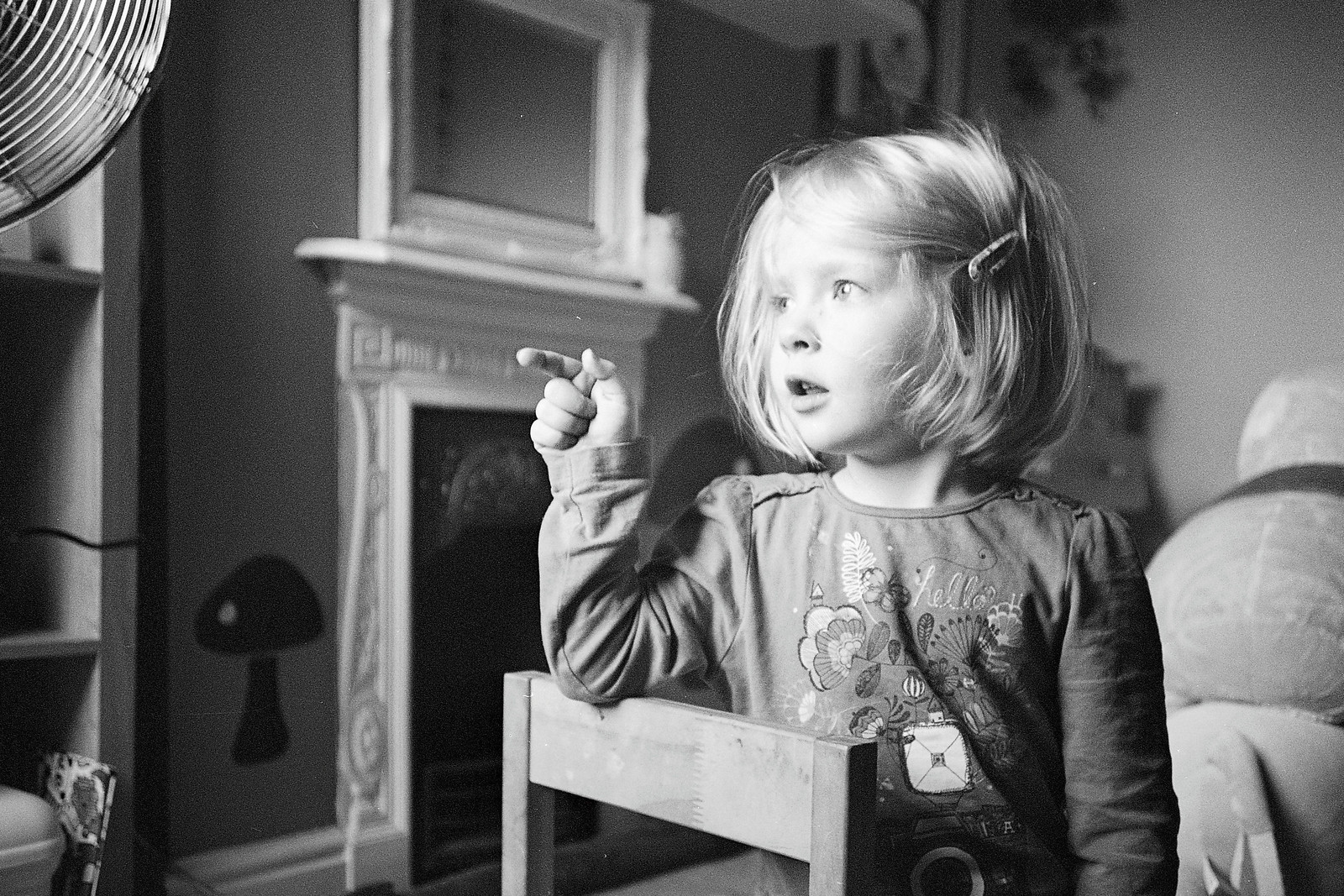
Before I get to that though, a quick run through of just how limited and more importantly limiting this camera is…
Olympus AF-10 Super’s Flash
Firstly, as demonstrated in a my previous post – ‘Flash switch hack for the Olympus AF-10 super‘ – this camera has very basic flash settings. Though they can be fairly easily modified to be completely manual.
Focusing and speed to photo
One of the best things about this camera is how responsive it is. Half press activates the camera to be ready to shoot near instantly, and when you press the button its response feels very eager. Maybe I was just lucky with first my roll, but despite this speed, it didn’t miss focus on a single shot of an entire roll. And that included shots where I had half pressed to focus, reframed and then shot.
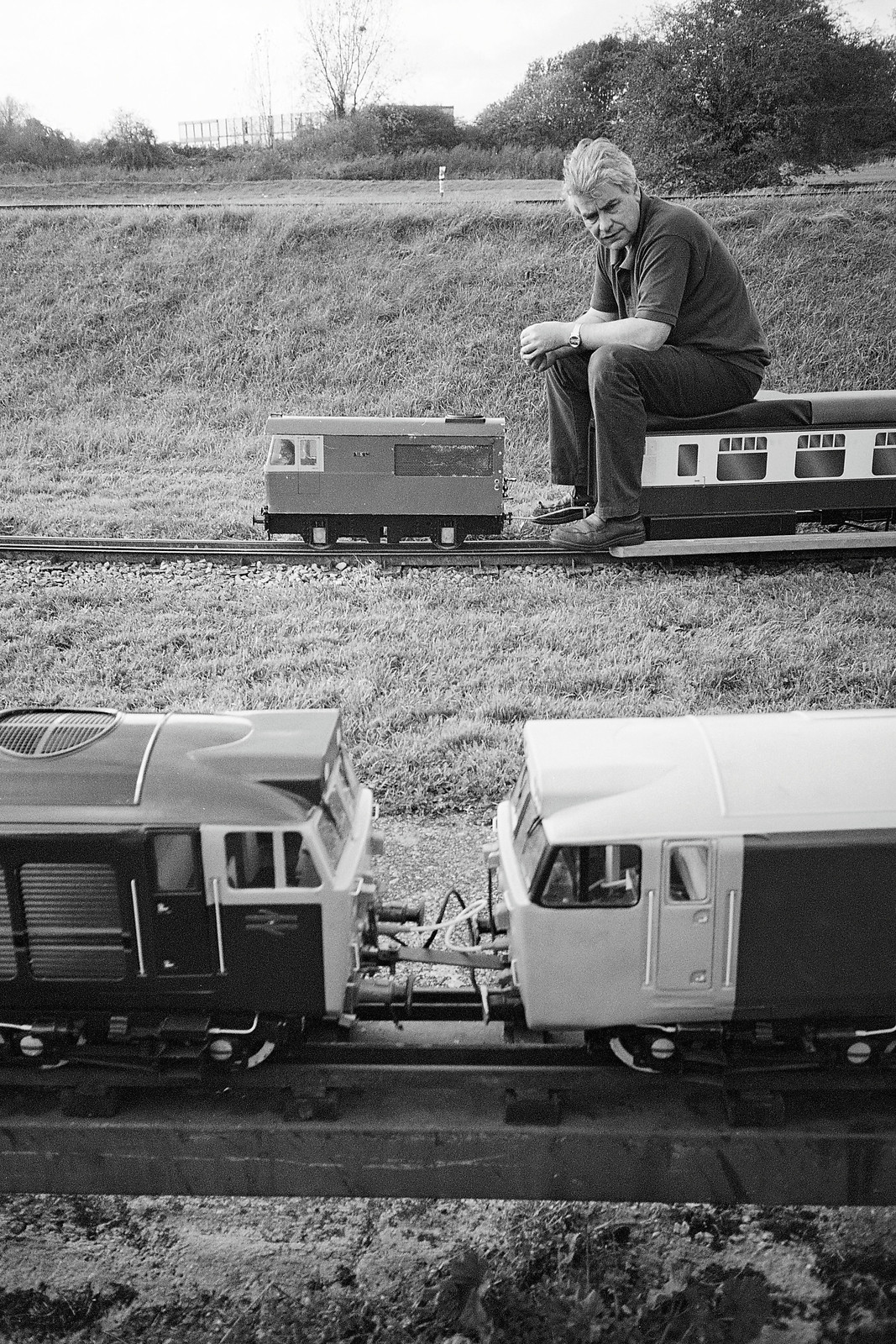
The photos
It actually takes a half decent photo. Ok, we aren’t talking quite the same quality as its relative the mju-ii, or any other premium or advanced compact camera for that matter, but it’s pretty bloody impressive for such a cheap camera. And it’s certainly good enough for happy snaps! I certainly wasn’t disappointed at all, or in anyway wished I had taken any of these shots with a different camera! Results are sharp, reasonably contrasty, vignette a bit, and sometimes perhaps look a little veiled, but overall they are good!
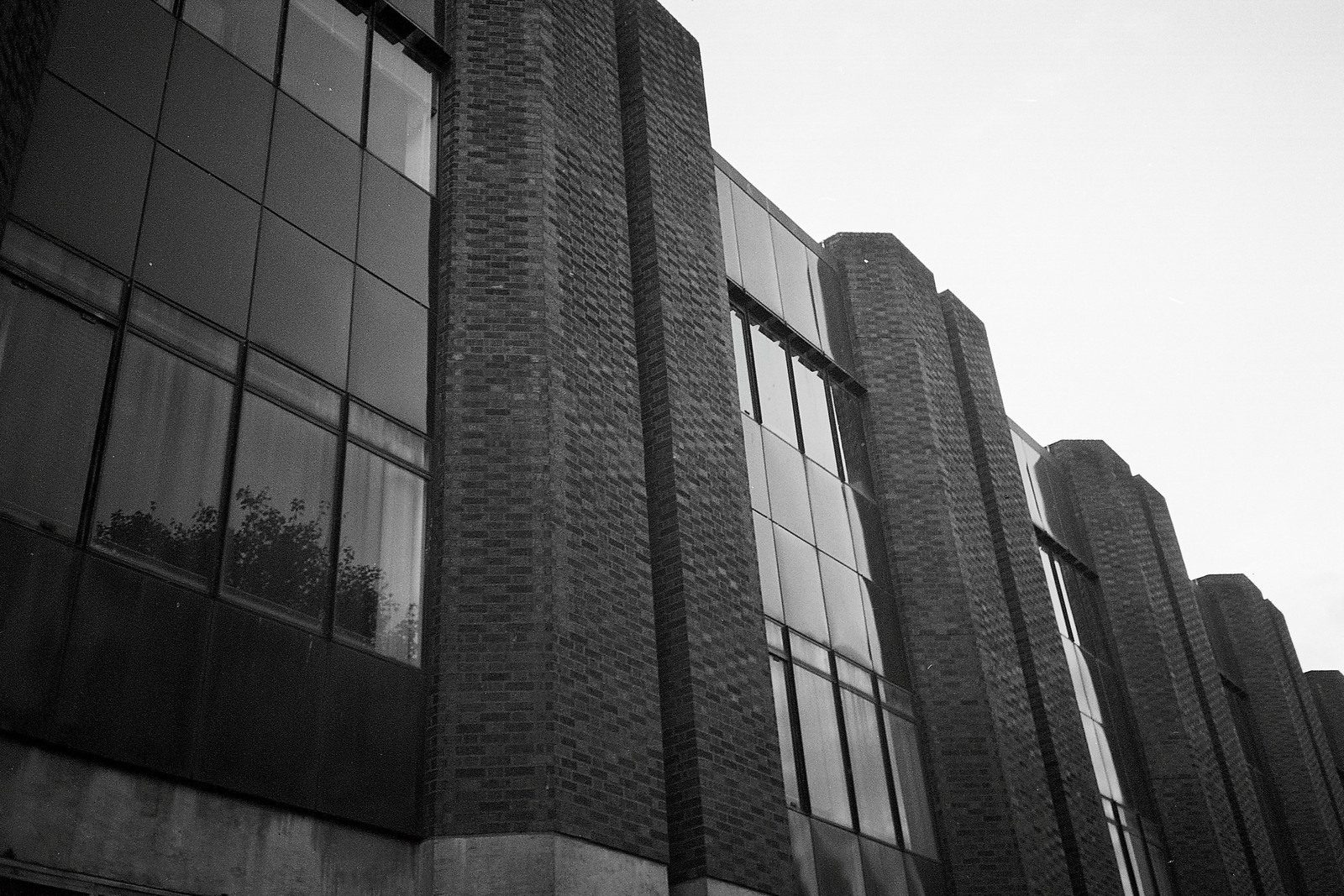
Other features?
So it takes passably decent photos, it takes them without any fuss and quickly… All sounds pretty good then? Well not quite; if you are looking for feature packed, it might be worth while going elsewhere. Other than the flash switch, and of course shutter, the only on button on the camera is for a self-timer. It doesn’t even have a button for rewinding the film before then end. Even the little lights in the viewfinder are low on function. Admittedly, the flash activated light illuminates when it is going to use flash, but the AF light illuminates every single time the shutter button is half pressed. It has never once reported missed focus even when I put my hand over the all of the sensors and lens to test it. Basically it’s just a half-press-light.
The biggest limitation…
The lack of user controllable features isn’t even its biggest limitation. The real cap on function is the light meter shutter/aperture limitations. The cameras light meter spans 6ev. Ev9 – Ev15 (100iso), which means – or is a product of – the mechanical limitation of the camera – 1/45th at f3.5 to 1/400th at f9.1
… that actually makes the camera actually quite useable
Although this latter specification is limiting, it is also where the real joy of shooting a camera like this comes in for me. The enjoyment becomes about working with these limitations rather than letting them be a hindrance.
I’ve mentioned a few times on this blog now that I have a distaste for cameras that given a slightly lower light situation will err toward using inappropriately long shutter speeds in preference to their widest aperture. The result of this is obvious, in low light these unpredictable and often unnecessarily slow shutter speeds result in photos that suffer with motion blur. Well this camera out-craps and out-does those cameras simultaneously. It doesn’t have the slow shutter speeds available to it to use, even if it is programmed that way. It’s lowest shutter speed is only 1/45th, which is plenty fast enough for hand holding a 35mm lens… Well, at least as long as the subject is relatively stationary… …
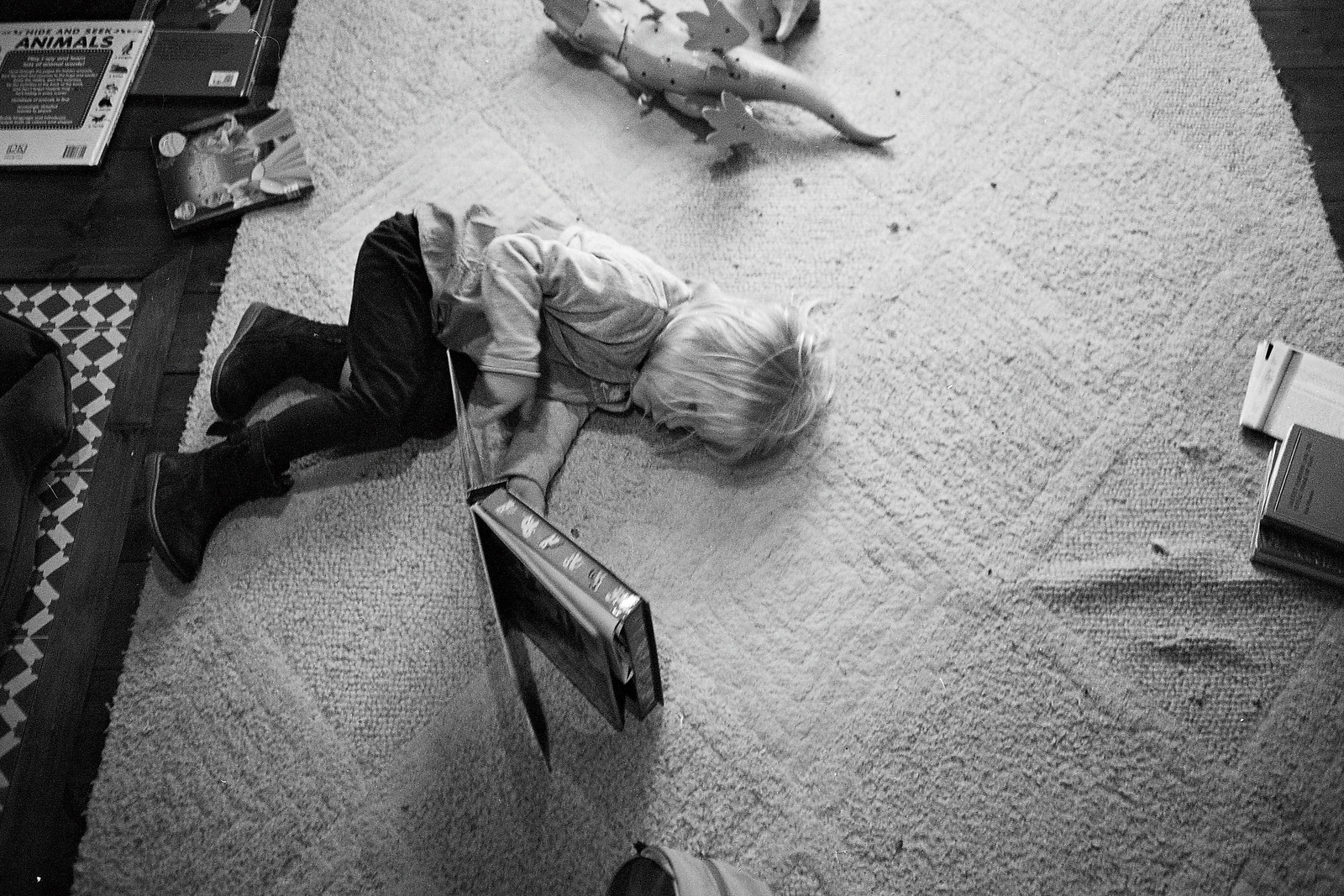
Now clearly this limited range of function is designed to be inexpensive, and I suppose help the entirely uninformed take a better photo. But my point is that it can also be helpful if you know what you are doing.
Compare it for a second my Pentax Espio Mini having put 400iso film in both cameras and then using them in my living room in the evening. My living room is about 6ev, s0 at 400iso with the 3.5 lens – which both of these cameras have – this should result in a shutter speed of around 1/20th. Which – being as it is a much higher spec camera with a much wider light meter and shutter speed range – is exactly what the Pentax will do. But of course the slowest shutter speed this Olympus can muster is 1/45th, so that is what it will use. Of course this would be a whole stop under exposed. But assuming I am taking a photo of a person or something else that moves around a bit, that 1ev of underexposure might in fact be preferable to the slower shutter speed, especially if I am shooting the likes of XP2 which has plenty enough latitude to cope with 1ev of underexposure. The point being, given this fairly specific circumstance, I actually have more sense of control over the lesser camera.
Shooting the Olympus Af-10 Super in very low light
Now clearly the above is quite a specific circumstance, but actually it could, given the inclination, make this camera quite fun to use in much lower light. A little bit like the Olympus trip 35 (skip to the end of the post to read what I’m talking about). Since this camera has no possibility of taking a photo at a slower shutter speed than 1/45th with an aperture of 3.5, the control of the camera in low light is put into the hands of the photographer by means of the film speed. And since the cameras DX code reader doesn’t go above 800iso, and more importantly seems to default to 50iso given no DX code, in low light, it is pretty easy to manipulate the camera into always selecting those f/3.5 and 1/45th by either taping over the DX code on a film or putting out of range film in the camera.
For example, if I were to go out shooting with this camera loaded with 3200iso film, the camera wouldn’t be able to read the DX code, and so, in lower light, would use f/3.5 and 1/45th. f/3.5 and 1/45th with 3200iso film is EV4. EV4 is what you might expect shooting in a well-artificially-lit city centre at night, a reasonably lit bar etc. Since it’s film, a bit of overexposure doesn’t hurt, so there is room for error if there is more light than EV4. And actually, if you go through with this sort of experiment, you’re also probably the sort (like me) that doesn’t mind a bit of underexposure in your low lit shooting… A little bit of underexposure won’t hurt either.
All these following photos were taken with Ilford HP5 (with the dx code taped over) shot then deved in DD-X using times for pushing it to 3200
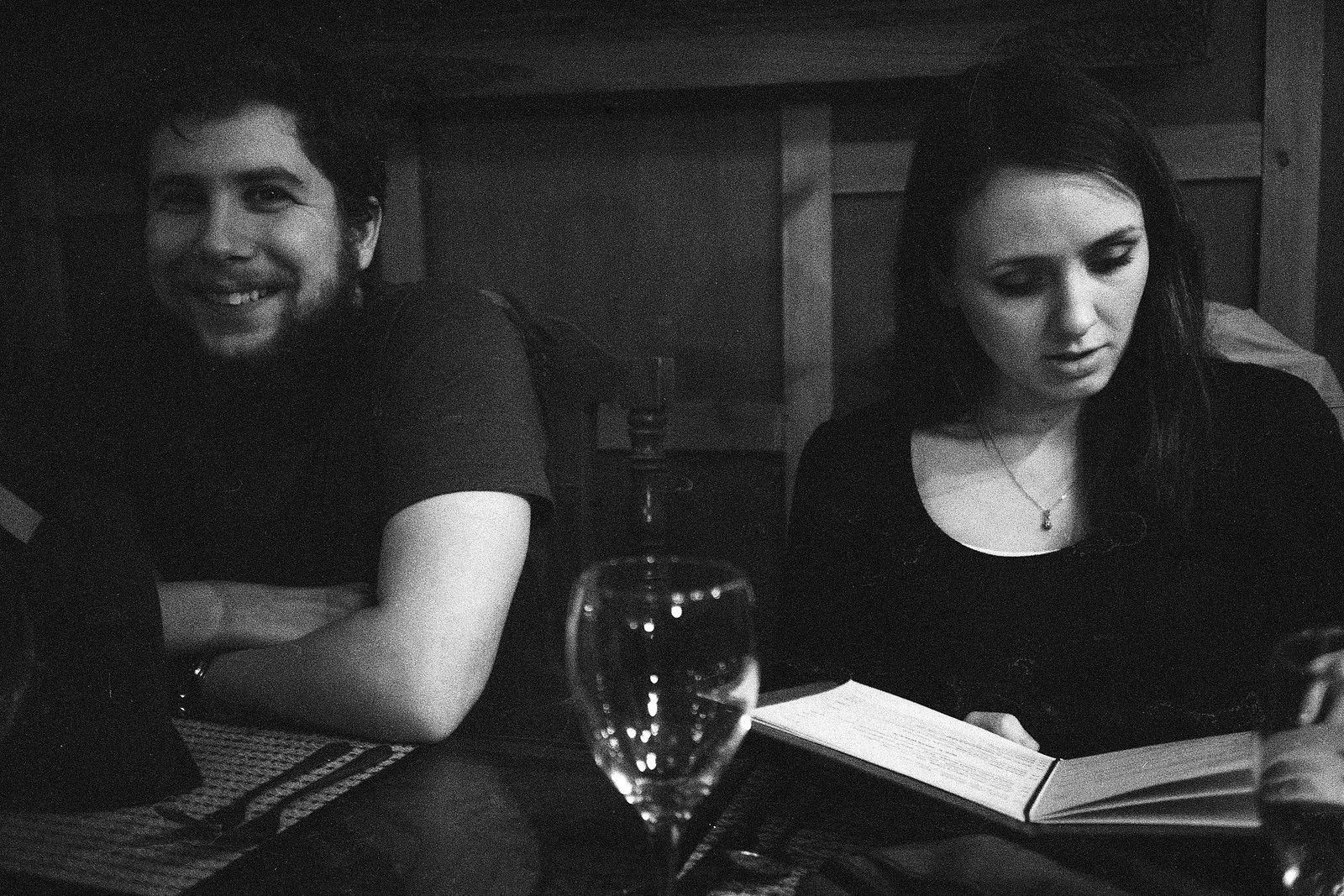
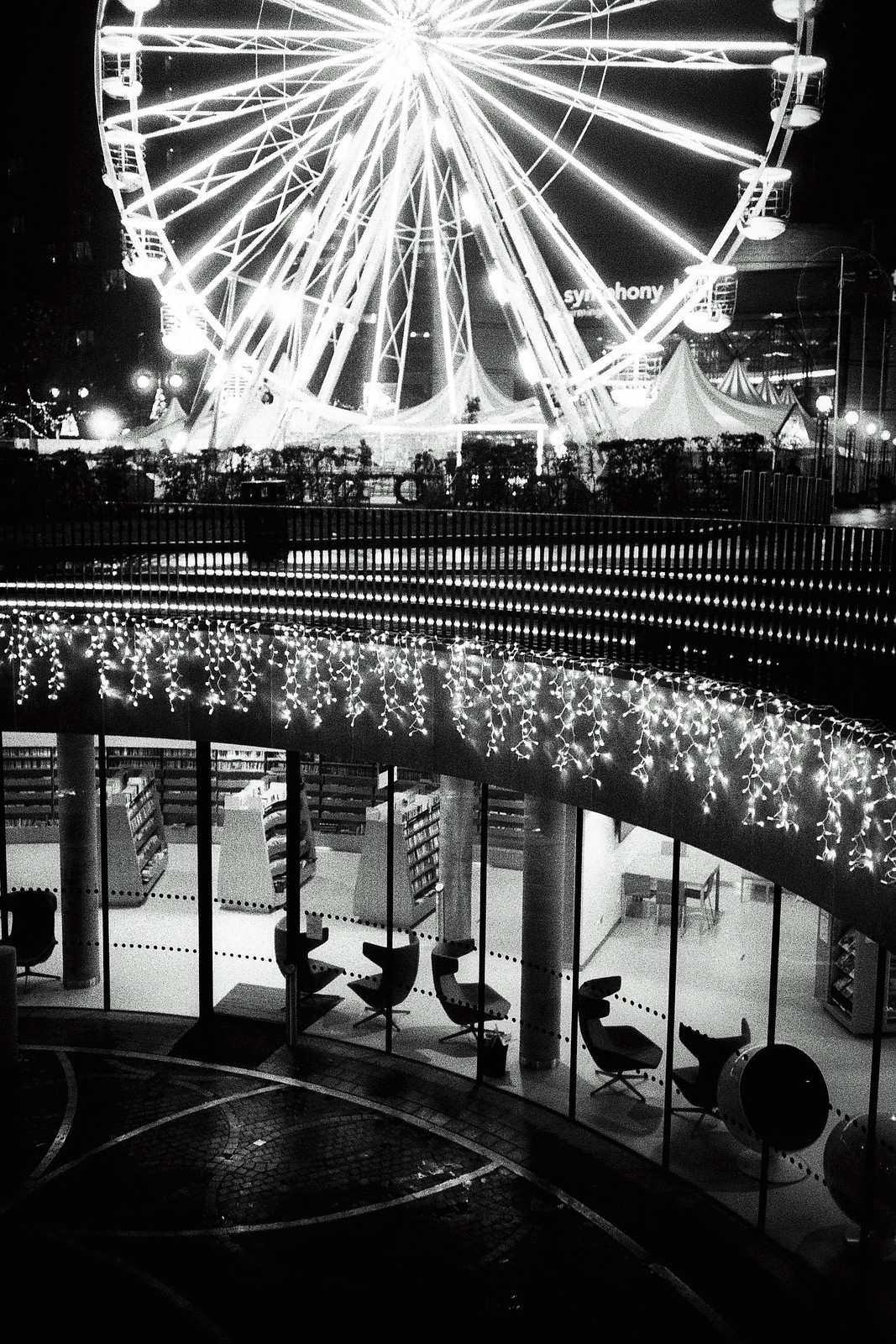
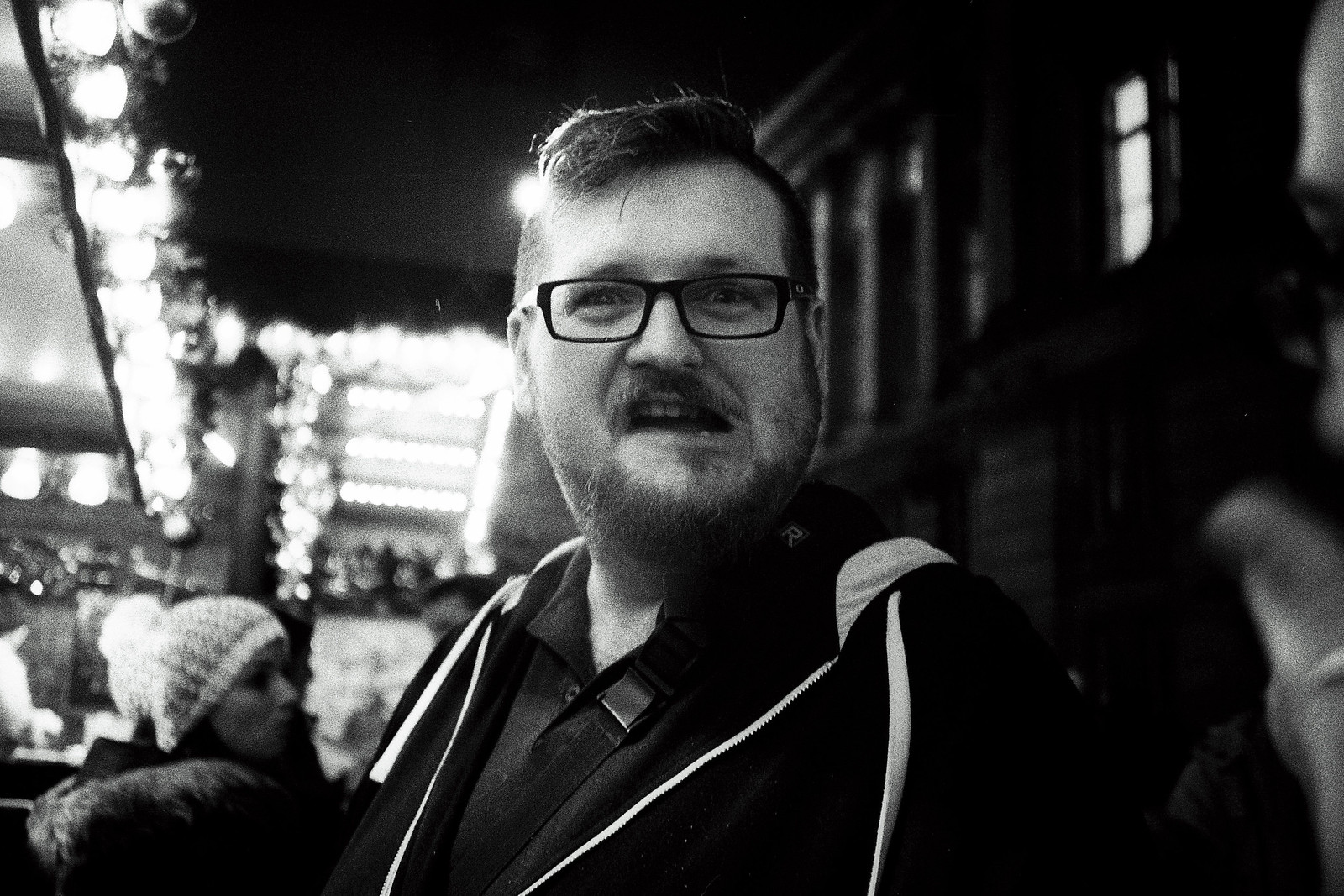
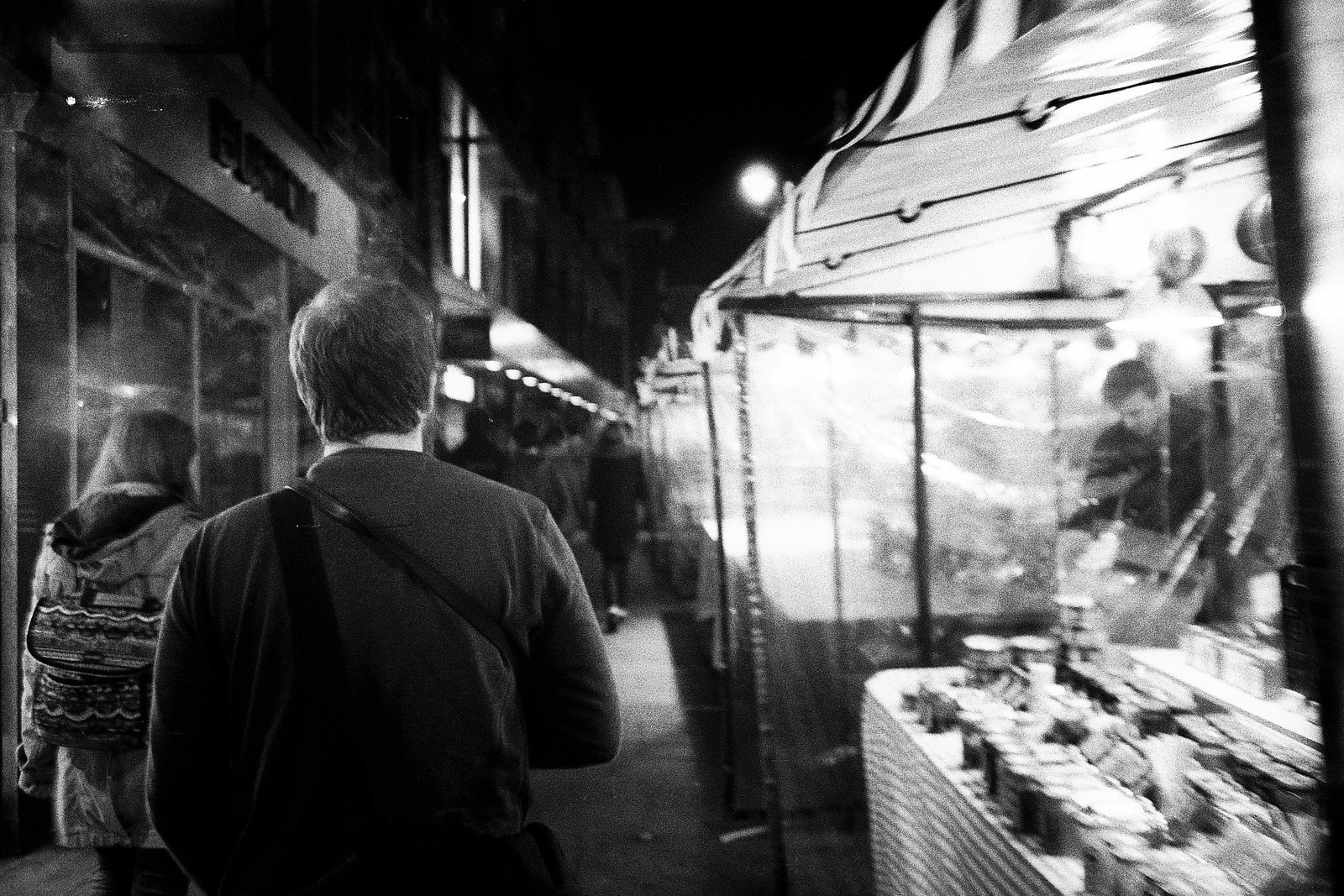
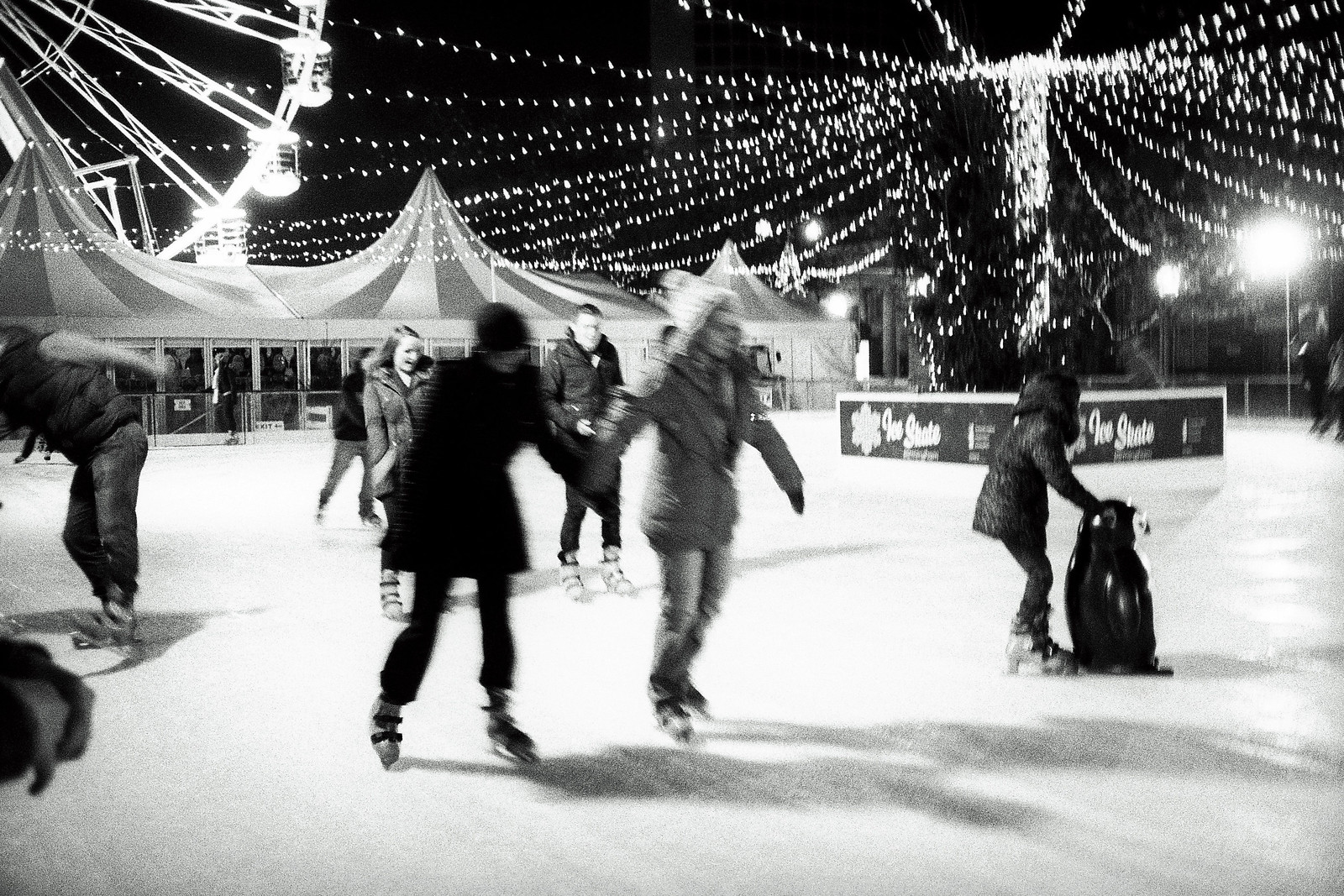
There is one last thing that this camera has going for it above many other compact cameras like it. And this is the autofocus system. Because it’s Active and therefore works by means of reflected infrared beam, it works in the dark too… So you should get a sharp photo… as long as the subject stays still…!
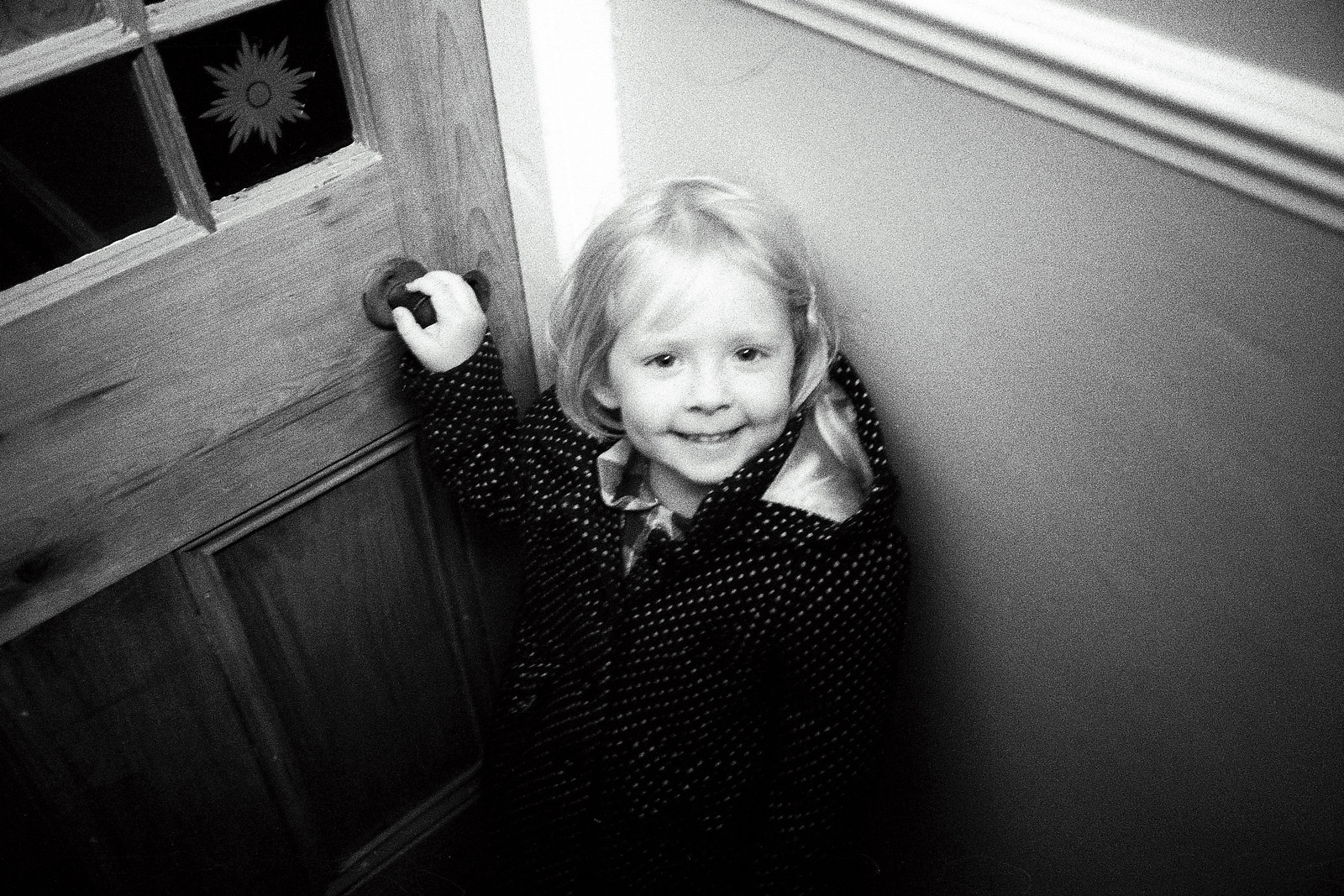
Of course, you might – as many people would – ask yourself what’s the point in all this? Why not just use flash, or a camera with a faster lens that can actually be controlled manually…? Well, it’s as simple as this, if you are reading this and asking that question, there probably is no point! Alternatively, if you are reading this and thinking “that sounds like a bit of fun”… then crack on and give it a go! It might not be for everyone, and most of the time, in truth, it’s not for me… But once in a while, messing around with a camera like the Olympus AF-10 Super, outside of its specified functional limitations, just gives me quite a sense of satisfaction… Especially when a few of the photos come out so well … And I bloody love HP5 pushed in DD-X!
Cheers for reading
Hamish
Share this post:
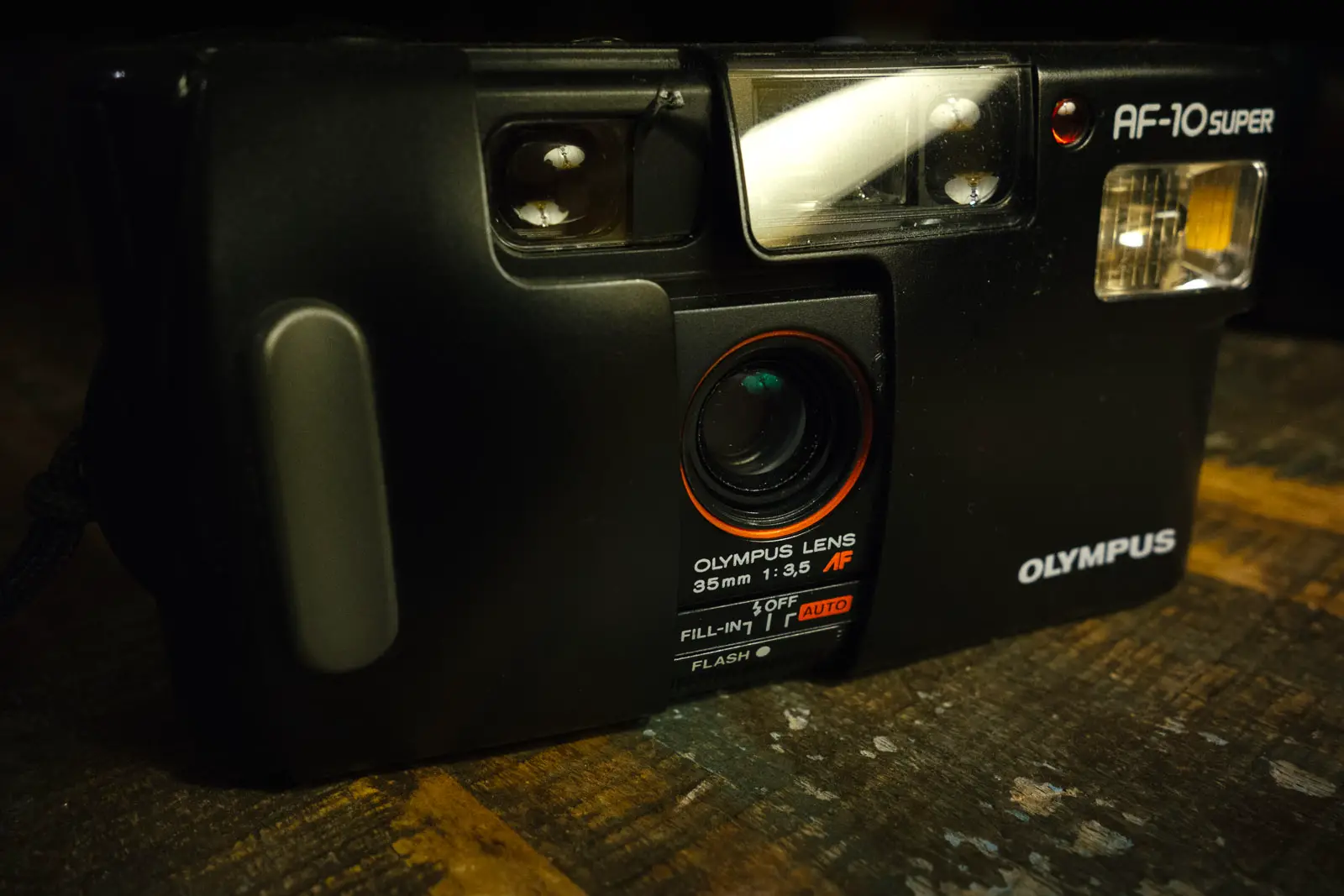








Comments
ehpem on Olympus AF-10 Super Review, or: Pushing the functional limits of a crap point & shoot.
Comment posted: 11/01/2015
I suspect the design limitations are justified as much by likelihood of taking a good picture when in inexperienced hands as they are by expense. They could even be done solely with that purpose in mind since camera shake must be the most common source of out of focus pictures.
Comment posted: 11/01/2015
ehpem on Olympus AF-10 Super Review, or: Pushing the functional limits of a crap point & shoot.
Comment posted: 11/01/2015
Comment posted: 11/01/2015
JR on Olympus AF-10 Super Review, or: Pushing the functional limits of a crap point & shoot.
Comment posted: 18/01/2015
I thought I'd ask you to clarify something about the AF-10: How does the shutter/AF lag compare to the Stylus, Stylus Epic, and Espio Mini? I have these cameras as well except for the Epic (yet), and one major disappointment was the shutter lag. It's just not good enough to capture the moment. I've been looking for a budget knockabout AF compact with 35mm lens and fast AF. So... is this it? And can you tell if it moves the focusing mechanism into place upon half press (as opposed to upon full press)?
Thanks!
Comment posted: 18/01/2015
Shah on Olympus AF-10 Super Review, or: Pushing the functional limits of a crap point & shoot.
Comment posted: 21/02/2015
Comment posted: 21/02/2015
Comment posted: 21/02/2015
Comment posted: 21/02/2015
Nick on Olympus AF-10 Super Review, or: Pushing the functional limits of a crap point & shoot.
Comment posted: 01/03/2015
Great find stumbling across and seeing your write ups - very personal and informative. I'm a student looking for a point and shoot for street photography, capturing every day life with friends. Therefore I'm looking for a point and shoot that feels very responsive, so shots on the go will be sharp and in focus. What would you recommend between the AF 10, Pentax Espio mini and the mju II? (There is also a very big jump in price between these cameras!) AF 10 being the cheapest.
Thanks in advance,
Nick
Comment posted: 01/03/2015
Comment posted: 01/03/2015
Christos Theofilogiannakos on Olympus AF-10 Super Review, or: Pushing the functional limits of a crap point & shoot.
Comment posted: 14/10/2015
Comment posted: 14/10/2015
Comment posted: 14/10/2015
Yassine on Olympus AF-10 Super Review, or: Pushing the functional limits of a crap point & shoot.
Comment posted: 11/01/2016
I still have it, and while I'm in the process of rediscovering film photography with a Canon EOS 300X (with around 10 rolls dones but only a few like 2 or 3 photos from them posted on Flickr as I lack a competent scanner), I also decided to give it another try, loading up some Ilford "C41 process black and like" inside. I think that with its easy operation and fixed 35mm focal length, it might be an interesting camera for street photography, enabling the photographer to concentrate solely on composition and never missing a moment.
Your photos with it gave me a lot of inspiration and motivation to get that oldie back into action, along with some other "dumb cameras" from the nineties I collected, thank you very much !
Comment posted: 11/01/2016
chris chinnock on Olympus AF-10 Super Review, or: Pushing the functional limits of a crap point & shoot.
Comment posted: 13/02/2016
Comment posted: 13/02/2016
Matthew on Olympus AF-10 Super Review, or: Pushing the functional limits of a crap point & shoot.
Comment posted: 05/02/2017
Cheers
https://www.flickr.com/photos/kitschiguy/albums/72157631130431988
Comment posted: 05/02/2017
Jerome Yeats on Olympus AF-10 Super Review, or: Pushing the functional limits of a crap point & shoot.
Comment posted: 18/02/2017
Why not term it a stripped down compact camera? Almost any camera can be made to provide good photos within its limits.
Why the faded grey text for replies? Now that is crap.
Comment posted: 18/02/2017
Ned on Olympus AF-10 Super Review, or: Pushing the functional limits of a crap point & shoot.
Comment posted: 29/06/2017
Comment posted: 29/06/2017
Comment posted: 29/06/2017
Comment posted: 29/06/2017
Thinking about spending a stack of cash on a film camera? Read this first! - 35mmc on Olympus AF-10 Super Review, or: Pushing the functional limits of a crap point & shoot.
Comment posted: 22/01/2019
These Olympus commercials from the 1980s show that attitudes towards gear never really change - DIY Photography on Olympus AF-10 Super Review, or: Pushing the functional limits of a crap point & shoot.
Comment posted: 21/02/2019
Do you actually need a Yashica T4? Or: An Attempt for the Purest “Cult vs. Budget” Comparison Ever - By Dmitry Zhilyaev - 35mmc on Olympus AF-10 Super Review, or: Pushing the functional limits of a crap point & shoot.
Comment posted: 30/08/2019
Dimosbox.gr Blog - Film Fridays: Olympus AF-10 Super - pushing the functional limits of a cheap point and shoot - on Olympus AF-10 Super Review, or: Pushing the functional limits of a crap point & shoot.
Comment posted: 04/04/2020
Chris on Olympus AF-10 Super Review, or: Pushing the functional limits of a crap point & shoot.
Comment posted: 29/05/2020
Are you aware of any way to manually adjust the exposure counter? My counter was set at "28" when I loaded a fresh film... it correctly rewound to 1 when I finished my roll, but when I opened the rear door it again reset to 28 instead of "S".
Im guessing the last owner had a battery drain issue or removed the film without an automatic rewind, but I cant work out a fix :S
Comment posted: 29/05/2020
Alastair Wilson on Olympus AF-10 Super Review, or: Pushing the functional limits of a crap point & shoot.
Comment posted: 08/05/2021
Used to shoot a fair bit of B&W with it and got good candids of people on my travels.
Just found some colour shots taken on it - surprised how good they are.
Planning on shooting some film through it - still haven't kicked the film habit.